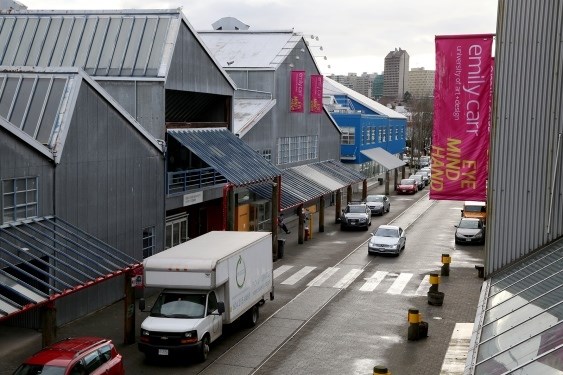It’s been a while since I visited Granville Island. So on a recent Friday afternoon I parked myself outside the food market with an overpriced burrito and enjoyed the view.
Granville Island, a federal government initiative involving mixed-use of space by retail, commercial, industrial, and public interests, debuted in 1979. There were many skeptics of this experiment in “new urbanism,” but the spot turned out to be one of the second biggest tourist draws to the city next to Stanley Park.
Surprise, surprise: it turns out that a food market, cement plant, boatyard, art school, community centre and water park could fit together comfortably with restaurants and theatres.
Watching the bulbous Aquabus bob over to the north side of False Creek, I thought back to a favourite Granville Island moment from years back, during the now defunct Comedyfest. At the count of three, a comic had his outdoor audience point their fingers at the Granville Bridge and yell out in unison, “Hey you!” A pedestrian on the bridge popped his head over the edge of the railing to look down, as hundreds of people burst into laughter.
On this Friday afternoon, the market was busy but manageable to navigate. Wandering over to the False Creek community centre and over to Ron Basford park, I was struck how Granville Island feels more like an urban oasis than ever before.
“This is beautiful,” I thought, at the pinnacle of Basford’s open air amphitheatre.
Increasing numbers of areas in Metro Vancouver are defined by skyscrapers and their darkened canyons, and Granville Island is one remaining urban development where sunlight isn’t trumped by shadow. But given Vision Vancouver’s enthusiasm for vertically directed ecodensity, it was probably only a matter of time before we’d start hearing about how old and stodgy Granville Island is.
A February editorial in the Vancouver Sun bore the headline, “It’s time to re-imagine and renew Granville Island.” The peg in the story is the planned relocation of Emily Carr School of Art to Great Northern Way, which will open up 200,000 square feet of space and two buildings.
Obviously something new and inventive is needed in Emily Carr’s absence, and the Sun isn’t off-base in claiming that Granville Island is dead at night. What concerns me is the insistence that the place is “looking a bit dated” at 35 years of age, and the departure of the art school is “an opportunity for a modernization of the entire site.”
It could use sprucing up in places, but from another perspective, 35 years of age makes much of it a retro gem. Modernize “the entire site”? Let’s not forget Vancouver’s sublime Orpheum Theatre, which first opened in 1929, was narrowly spared the wrecking ball in 1979.
The editorial advocates wresting control of Granville Island away form the Canadian Housing and Mortgage Corporation, while looking to the Vancouver International Airport Authority’s transformation of YVR as a good template. But last time I checked, airports are still considered departure and arrival points, not spots travellers care to linger at.
The ’70s government initiative that made Granville Island drew on input from Vancouverites. I would hope a rehaul of Granville Island would draw on local feedback from non-developers, without it turning into public hearings Kabuki theatre, for a done deal that benefits offshore investors who leave their properties empty.
I don’t share Sun editorial writer Daphne Bramham’s conviction that stakeholders “will ensure that Granville Island 2.0 isn’t cluttered with tourist shops, global chains or condos and that its next incarnation is even better than the first one.” I’m not convinced it’s unavoidable, either. Yet given the boxy monoculture of commercial and residential development in this city, and the intense pressure to maximize profit per square metre, I fear it will be a Bride of Frankenstein makeover.
Will this sunlit patch of city be left in the dark, like the glass canyons downtown?
In the classic 1961 book The Death and Life of Great American Cities, Canadian urbanist Jane Jacobs wrote, “There is no logic that can be superimposed on the city; people make it, and it is to them, not buildings, that we must fit our plans.” Her advice is still worth heeding.geoffolson.com



